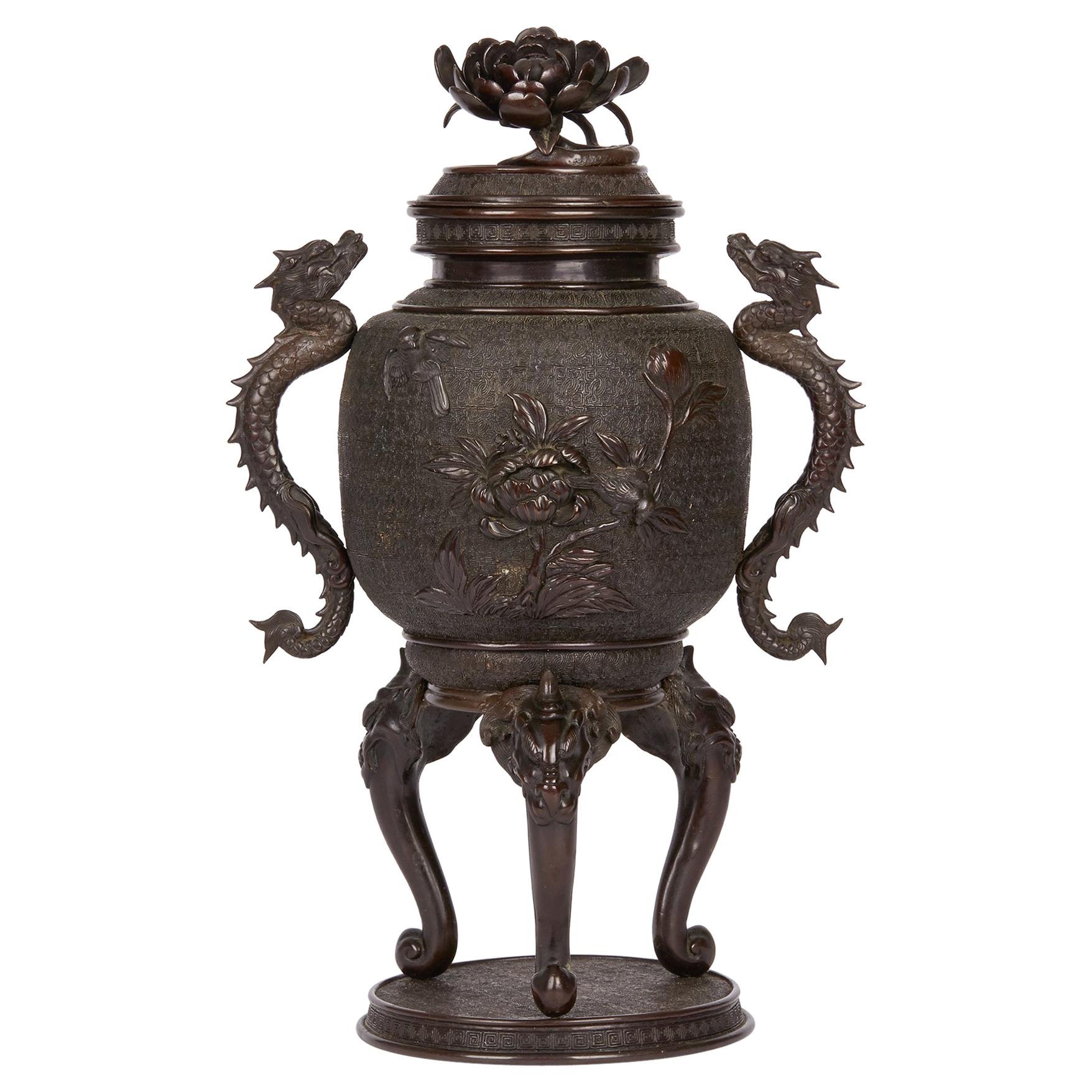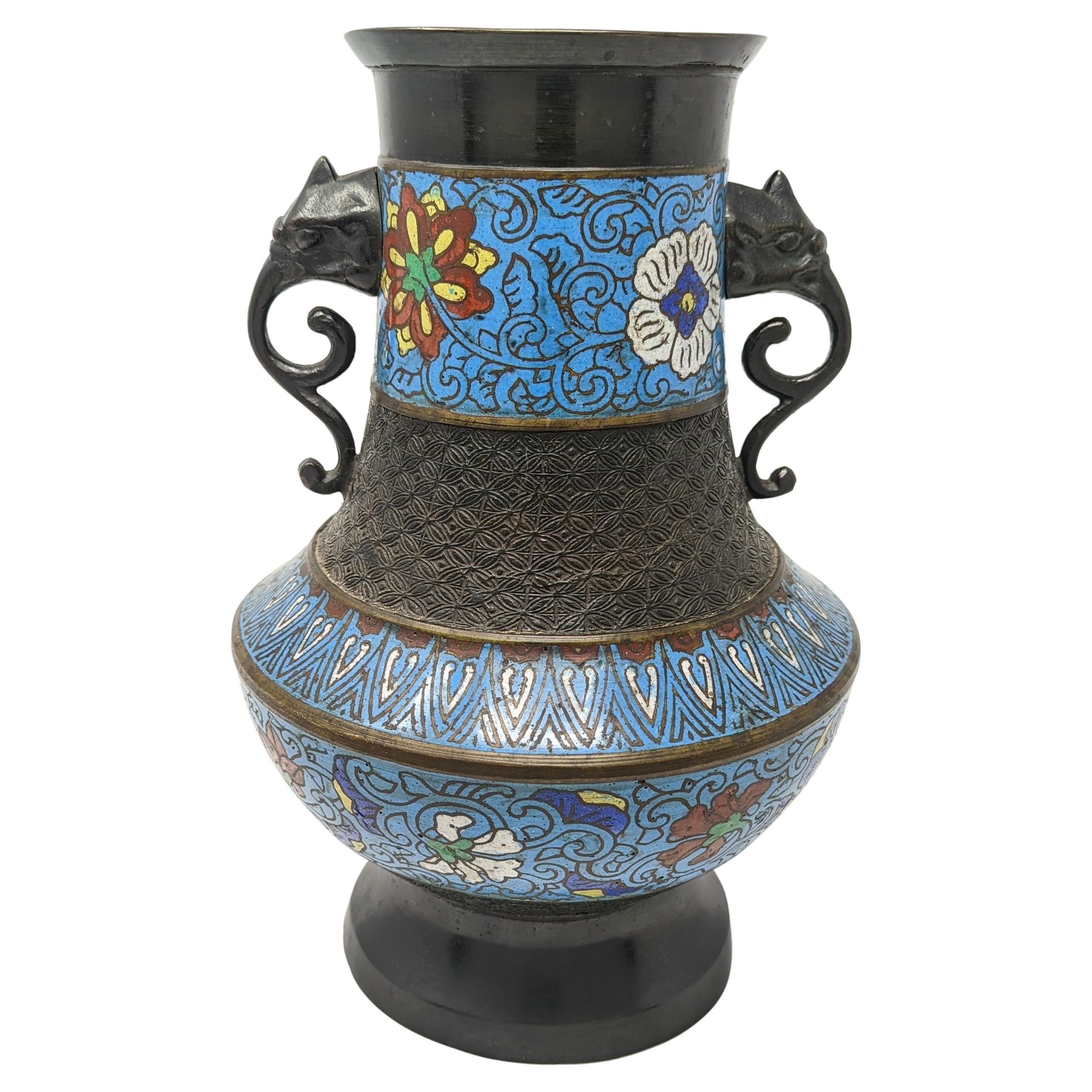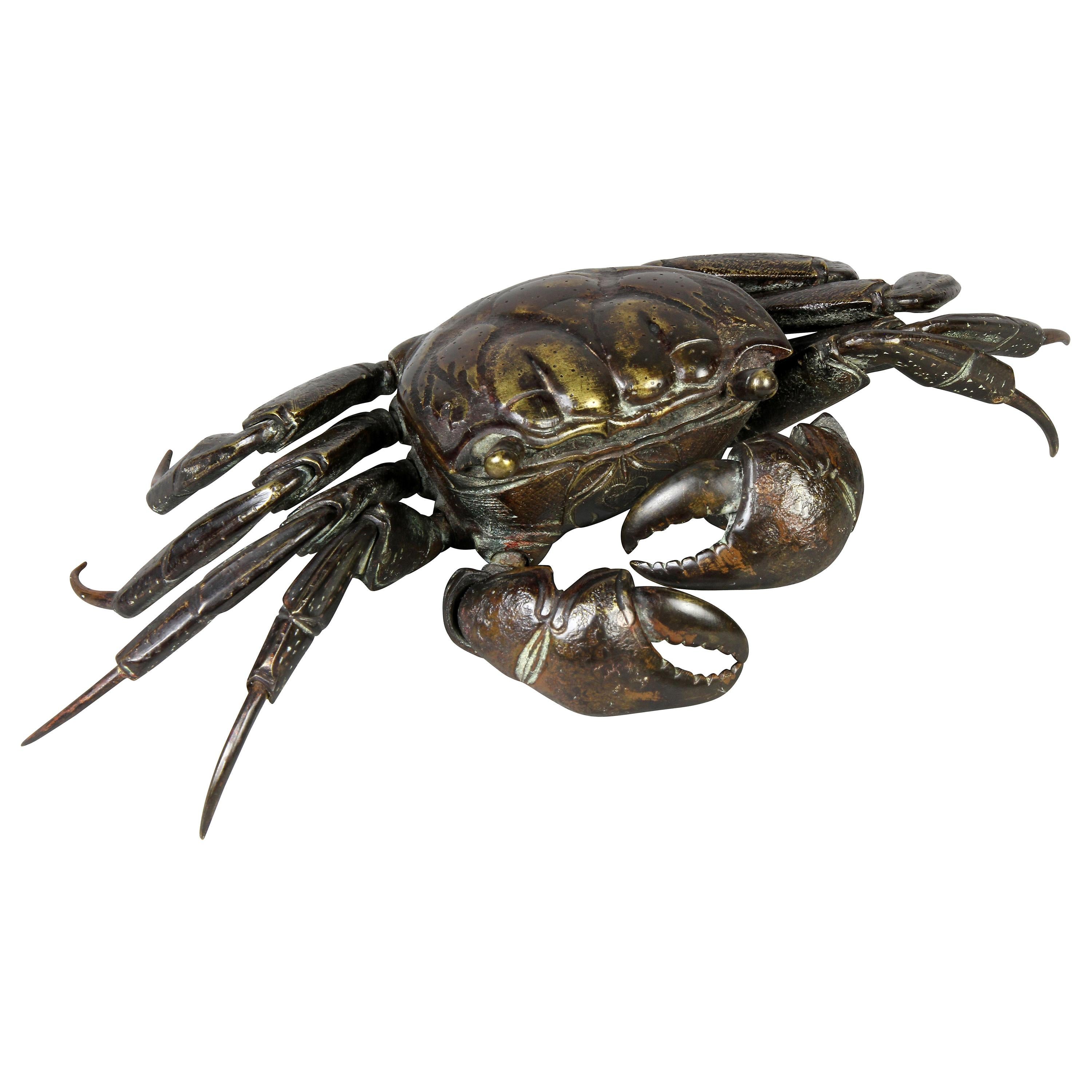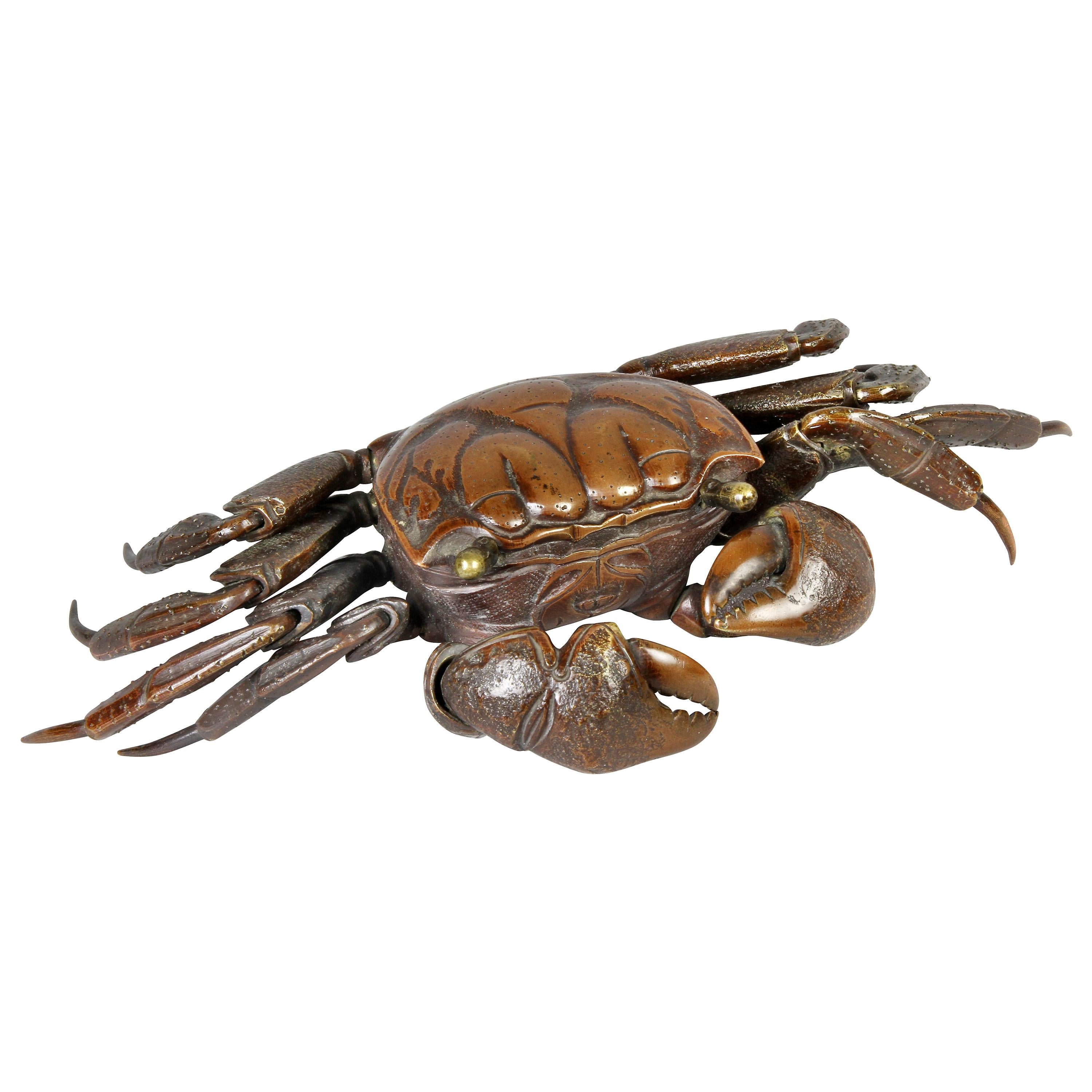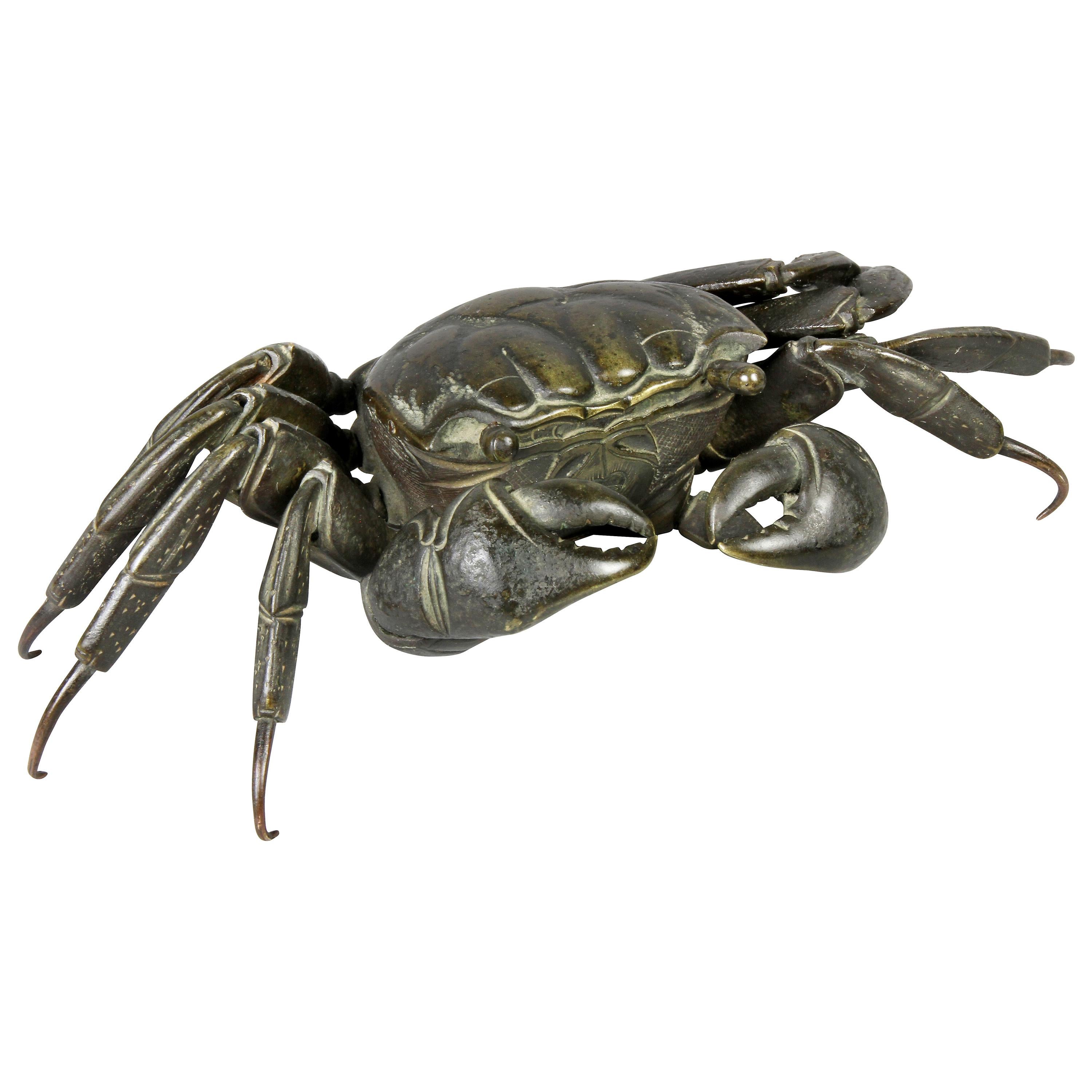Items Similar to Japanese Meiji Champleve and Bronze Urn
Want more images or videos?
Request additional images or videos from the seller
1 of 11
Japanese Meiji Champleve and Bronze Urn
About the Item
Presenting a gorgeous Japanese Meiji Champleve and bronze urn.
Made in Japan during the Meiji Period circa 1880.
The body of the urn is cast bronze and it is entirtely covered in various colored enamels in the manner of Champleve, depicting dragons, birds of paradise and floral motiff’s.
The pithing to the enamel is indicative of it’s genuine age and the bronze has a naturally aged patina. The inside of the urn likewise exhibits real age.
It is very unusual to find champleve pieces that cover almost the entirety of the piece.
At some stage in it’s life (we believe circa 1920-ish) someone decided to convert this into a table lamp. Not only that, but they replaced the interior base (which had probably corroded with use as a planter) with the backing of a Japanese Bronze Mirror. They then drilled a hole in the base and side for wiring. Both are now filled. The mirror is intriguing in itself. It appears to have been a quality mirror as the symbols, script and decoration as quite exceptional. It is impossible to tell if it was a reproduction of a 16th Century Japanese hand Mirror and the symbols appear to indicate that it was made in the Tensho Area in 1580 and a signature. Other symbols seen to indicate ‘Heaven’ and ‘Crane”. Because it was used to replace a base I would err on the side of caution and form the opinion that it was a reproduction hand mirror, albeit a very high quality one !
There is one minor crack where the base meets the enamel, but it does not adversely affect the piece.
Large and impressive piece measuring 14 inches tall and with a diameter of 14 inches.
A Stunning Example Of Meiji Japanese Champleve !
Tensho was a Japanese era name (nengo, “year” name) after Genki and before Bunroku. This period spanned the years from July 1573 through December 1592. The reigning emperors were Ogimachi-tenno and Go-Yozei-tenno .
The Meiji era (Meiji, is an era of Japanese history which extended from October 23, 1868 to July 30, 1912. This era represents the first half of the Empire of Japan, during which period the Japanese people moved from being an isolated feudal society at risk of colonization by Western powers to the new paradigm of a modern, industrialized nation state and emergent great power, influenced by Western scientific, technological, philosophical, political, legal, and aesthetic ideas. As a result of such wholesale adoption of radically different ideas, the changes to Japan were profound, and affected its social structure, internal politics, economy, military, and foreign relations. The period corresponded to the reign of Emperor Meiji. It was preceded by the Keio era and was succeeded by the Taisho era, upon the accession of Emperor Taisho.
Champlevé is an enamelling technique in the decorative arts, or an object made by that process, in which troughs or cells are carved, etched, die struck, or cast into the surface of a metal object, and filled with vitreous enamel. The piece is then fired until the enamel fuses, and when cooled the surface of the object is polished. The uncarved portions of the original surface remain visible as a frame for the enamel designs; typically they are gilded in medieval work. The name comes from the French for “raised field”, “field” meaning background, though the technique in practice lowers the area to be enameled rather than raising the rest of the surface.
- Dimensions:Height: 14 in (35.56 cm)Diameter: 14 in (35.56 cm)
- Style:Meiji (Of the Period)
- Materials and Techniques:
- Place of Origin:
- Period:
- Date of Manufacture:1880
- Condition:Replacements made: Base is a later replacement (a Japanese Bronze Hand Mirror) See full listing. Wear consistent with age and use. Minor losses. Minor structural damages. Enamel still mainly fully intact.
- Seller Location:Dallas, TX
- Reference Number:1stDibs: LU3978123955132
About the Seller
4.9
Gold Seller
These expertly vetted sellers are highly rated and consistently exceed customer expectations.
Established in 2015
1stDibs seller since 2018
349 sales on 1stDibs
Typical response time: <1 hour
- ShippingRetrieving quote...Ships From: Dallas, TX
- Return PolicyA return for this item may be initiated within 7 days of delivery.
More From This SellerView All
- Large Oriental Champleve Cloisonne Urn on StandLocated in Dallas, TXPresenting a beautiful and very high quality large oriental champlevé cloisonné urn on stand. Late 19th or early 20th century, circa 1890-1910. Pro...Category
Early 20th Century Japanese Japonisme Metalwork
MaterialsBrass, Bronze, Enamel
- Japanese Meiji Period Sterling Silver 2 Handled Basket by Katsu MiyamotoBy Miyamoto Shoko 1Located in Dallas, TXPRESENTING a GORGEOUS, VERY HIGH QUALITY and EXTREMELY RARE piece of Japanese Meiji Period Sterling Silver 2 Handled Basket by Katsu Miyamoto. EXQUISITE, EXCEPTIONAL, RARE & IMPORTANT! This is definitely a Meiji Period piece due to the fact that it is marked with the sterling silver mark “jungin”. The Meiji period was from 1868 to 1912 and in 1928 a law was introduced in Japan compelling the use of decimal marks for silver. This pre-dates that decimalization law. We are of the opinion that it is from circa 1900. Miyamoto Shoko was founded in 1880 as the first silverware specialty shop. In 1899, Miyamoto Shoko’s silverwares were ordered by the family members of the Emperor of Japan, and to this day, they are making fine and graceful handicrafts with skillful craftsmen. Loved by numerous customers since the Meiji era, Miyamoto Shoko’s products have also been given to Princess Mako and Princess Kako of Akishino, as well as Princess Aiko Toshinomiya, on their birthdays. Katsu Miyamoto (宮本勝), in 1880, in order to increase the sales of tobacco and cigarettes to foreigners founded the Moyamoto Shoko company, which produced different silverwares in general and particularly silver cigarette cases. Miyamoto’s first name, Katsu (勝) in some sources is written as “Masaru”, since 勝 kanji can be pronounced in both ways. This basket is of the HIGHEST QUALITY imaginable! The top of the basket has the MOST GORGEOUS repousse work of flowers, probably lotus flowers, with leaves and foliage. It has an underlying chevron effect chasing, reflecting parquetry. The 2 handles are cast in the form of bamboo handles. The rim of the top likewise is cast as bamboo. The base is equally stunning in a different way! It is chased with a chevron effect, like parquetry flooring and the four feet simulate pieces of sliced bamboo with an interlinking gallery of support columns, likewise, simulating bamboo. The QUALITY of WORKMANSHIP is OUTSTANDING! The pieces weighs exactly 525 grams. This piece takes my breath away! This is one for the SERIOUS COLLECTOR of EXQUISITE AND RARE Japanese silver. You will not find another like it, for sale ANYWHERE ELSE IN THE WORLD …… I know as I have searched! Provenance: Acquired from a Dallas Private Collector. Dimensions: 9.6 inches wide, 7.6 inches deep and 2.75 inches tall ( 7.25 inches tall with handles up) Condition: Very good. It looks like the base 4 legged gallery, has been repaired/re-attached to the base, but otherwise it is excellent and of Museum quality. The Meiji period (明治時代 Meiji-jidai?), also known as the Meiji era, is a Japanese era which extended from October 23, 1868 through July 30, 1912.[1] This period represents the first half of the Empire of Japan during which Japanese society moved from being an isolated feudal society to its modern form. Fundamental changes affected its social structure, internal politics, economy, military, and foreign relations. The period corresponded with the reign of Emperor Meiji after 1868, and lasted until his death in 1912. It was succeeded by the Taishō period upon the accession of Emperor Taishō to the throne. Solid silver pieces...Category
Early 20th Century Japanese Meiji Metalwork
MaterialsSterling Silver
- Antique Indian Dhokra Horse and Rider SculptureLocated in Dallas, TXPresenting a lovely antique Indian Dhokra horse and rider sculpture. Probably from the late 19th or early 20th century as is evidenced by its natural patina and clear evidence of age. It depicts an Indian Warrior with a sword in his right hand mounted on his horse/steed. The warrior is in classical and ancient Southeast Asian Indian attire and he holds the horse’s reins in his left hand. The body of the horse is a series of lines (in the Classic Dhokra Style) and it has a tribal headdress...Category
Antique Late 19th Century Indian Anglo Raj Metalwork
MaterialsMetal
- Early 20th Century Gilt Metal Thai Khon DancerLocated in Dallas, TXPresenting a beautiful early 20th century Gilt Metal Thai Khon Dancer. Made in Thailand (South East Asia) circa 1920. It features a gilt meta...Category
Early 20th Century Thai Country Sculptures and Carvings
MaterialsMetal
- Vintage Chinese Double Happiness Wedding CandlesticksLocated in Dallas, TXPresenting a lovely vintage Chinese double happiness wedding candlesticks, a matching pair. Made in China in the early 20th century of bronzed pewt...Category
Early 20th Century Chinese Archaistic Metalwork
MaterialsPewter
- Meiji Period High Quality Japanese Bronze Vase by Yoshida ZoLocated in Dallas, TXPRESENTING a GORGEOUS and EXTREMELY RARE Meiji Period High Quality Japanese Bronze Vase by Yoshida Zo. Made in Kyoto, Japan circa 1885, by the famous bronze sculptor, Yoshida Zo. I...Category
Antique Late 19th Century Japanese Archaistic Sculptures and Carvings
MaterialsBrass, Bronze
You May Also Like
- Japanese Meiji Period Bronze and Champlevé Enameled CenserLocated in New York, NYThis Japanese censer incense burner, inspired by Chinese pieces, is of spheroidal form, the bronze body with polychrome champlevé enamel work flanked b...Category
Antique Early 1900s Japanese Meiji Metalwork
MaterialsBronze
- Large Japanese Meiji Bronze Lidded Urn, 19th CenturyLocated in Bishop's Stortford, HertfordshireA large and stylish antique Japanese Meiji bronze lidded twin handle urn standing on a rounded plinth base with tongue and grotesque head formed legs with dragon handles and a flat c...Category
Early 20th Century Japanese Meiji Metalwork
MaterialsBronze
- Large Bronze Japanese Champleve Enamel Double Elephant Handle Urn Vase JapanLocated in Greer, SCBeautifully crafted vintage Japanese urn shaped vase, featuring elephant head double handles in bronze and enamel. Colorful enamel adorns the vase...Category
Mid-20th Century Japanese Other Metalwork
MaterialsBronze, Enamel
- Japanese Meiji Articulated Bronze CrabLocated in Essex, MADarker brown patina with fully articulated body. Purchased in London by previous owner.Category
Antique 1870s Japanese Meiji Animal Sculptures
MaterialsBronze
- Japanese Meiji Articulated Bronze CrabLocated in Essex, MAWonderful patina and fully articulated. Purchased in London by previous owner.Category
Antique 1870s Japanese Meiji Animal Sculptures
MaterialsBronze
- Japanese Meiji Articulated Bronze CrabLocated in Essex, MADark greenish brown patina with fully articulated body. Purchased in London by past owner.Category
Antique Late 19th Century Japanese Meiji Animal Sculptures
MaterialsBronze
Recently Viewed
View AllMore Ways To Browse
We Japanese
Bronze Urn
Bronze Urns
Japanese Interior Furniture
Antique Bronze Urns
Antique Bronze Urn
Bronze Urn Antique
Bronze People
Late Bronze Age
Bronze Dior
Japanese Antique Other Japanese Antiques
Japanese Late Meiji
Japanese Symbol
Bronze Era
Circa Meiji
Circa Meiji Japanese
Japanese Influence Furniture
Forms Surfaces Bronze

